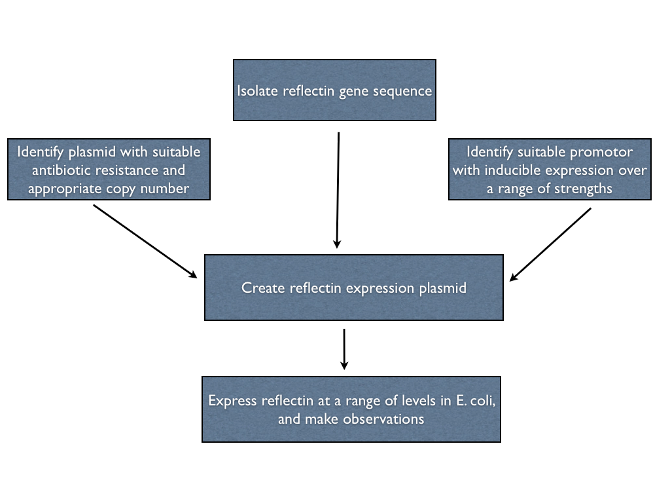Team:Cambridge/Project/In Vivo
From 2011.igem.org
(Difference between revisions)
| Line 1: | Line 1: | ||
{{Template:Team:Cambridge/CAM_2011_TEMPLATE_HEAD}} | {{Template:Team:Cambridge/CAM_2011_TEMPLATE_HEAD}} | ||
| - | = | + | =Expressing reflectin in E. coli= |
| - | + | ||
| + | To help pave the way for the manipulation of living structural colour, we investigated the properties of recombinant reflectins ''in vivo''. We designed multiple expression constructs to allow us to study reflectin under different conditions. An outline of our plan is given below. | ||
| + | |||
[[File:CAM_invivo_flow.png | centre | 670px]] | [[File:CAM_invivo_flow.png | centre | 670px]] | ||
==Isolating the reflectin gene== | ==Isolating the reflectin gene== | ||
| - | |||
| - | + | We initially attempted to clone reflectin genes from ''Loligo pealeii'' genomic DNA, but this proved difficult - extracting squid DNA is notoriously difficult and we were unable to obtain samples fresh enough to create a cDNA library. We are particularly grateful to Wendy Crookes-Goodson for her kind donation of plasmids containing reflectins codon-optimised for ''E. coli''. | |
| - | == | + | ==Designing expression constructs== |
| - | + | Promoter choice, copy number - justification | |
| - | + | ||
| - | |||
| - | |||
| + | ==Periplasmic Export== | ||
{{Template:Team:Cambridge/CAM_2011_TEMPLATE_FOOT}} | {{Template:Team:Cambridge/CAM_2011_TEMPLATE_FOOT}} | ||
Revision as of 11:47, 16 September 2011
Loading...
Contents |
Expressing reflectin in E. coli
To help pave the way for the manipulation of living structural colour, we investigated the properties of recombinant reflectins in vivo. We designed multiple expression constructs to allow us to study reflectin under different conditions. An outline of our plan is given below.
Isolating the reflectin gene
We initially attempted to clone reflectin genes from Loligo pealeii genomic DNA, but this proved difficult - extracting squid DNA is notoriously difficult and we were unable to obtain samples fresh enough to create a cDNA library. We are particularly grateful to Wendy Crookes-Goodson for her kind donation of plasmids containing reflectins codon-optimised for E. coli.
Designing expression constructs
Promoter choice, copy number - justification
Periplasmic Export
 "
"

